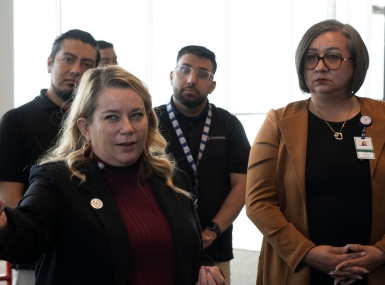Best Practices from NACo Achievement Award Winners
Upcoming Events
Related News

The Danray Home
Henrico County, Va.
In November 2013, Henrico Area Mental Health & Developmental Services created a new level of residential programming for people with serious and persistent mental illness. The Danray Home provides housing and support to five adult male clients who have expressed an interest in living independently, but who currently lack the skills and abilities to manage without the support of staff.
The unusual component of this program involves the staffing levels: Rather than having staff present 24 hours a day, seven days a week, staff is present at critical points throughout the day to provide support and education. These critical points typically occur early in the morning when residents are waking and again in the evening when residents are settling in for the night. Staff focus on teaching skills related to medication management, cooking, budgeting and housework.
During other parts of the day residents live independently giving them an opportunity to practice the skills they are learning. The primary objectives of this program are to increase residents’ independent living skills and to encourage integration into the larger community. This new level of residential support has resulted in decreased operating costs, and more importantly, improved outcomes for residents of The Danray House.
Homeless Outreach Support Team (HOST)
San Bernardino County, Calif.
HOST (Homeless Outreach Support Team) is an outreach-based program providing services in the field to get chronically homeless individuals with mental illness into permanent supportive housing. HOST collaborates with the Sheriff’s Homeless Outreach Proactive Enforcement (HOPE) team to conduct outreach events, go out into the field, and engage the most difficult and hard to reach clients. HOST staff works with qualified individuals to complete the necessary applications and assessments in the field and, upon receipt of housing voucher, will assist the individual to locate and move into housing.
HOST continues to offer recovery-based wrap-around case management services to the individual to assist them to recover, gain wellness and reintegrate into the community with the ultimate goal of independence and self-sufficiency.
Homeless Resource Center
Palm Beach County, Fla.
To affirm the need for and demonstrate its own commitment and leadership in ending homelessness, the Palm Beach County Board of Commissioners established the Palm Beach County Homeless Advisory Board. This board was chartered with the task of preparing and overseeing the implementation of the 10-Year Plan to End Homelessness in Palm Beach County.
The combined efforts of the board, community representatives and formerly homeless individuals led to adoption of the 10-Year Plan by the County Board in September 2008.
A Homeless Resource Center is one of the action steps identified in the 10-Year Plan to address centralizing and streamlining entry into the homeless service delivery system. On July 2, 2012, The county opened its first Homeless Resource Center — the Senator Philip D. Lewis Center. This Homeless Resource Center serves as the county’s central point of access for homeless services.
At the Lewis Center, in 90 days or less, homeless individuals and families receive high-quality services from a team of community partners, to return them to a self-sufficient lifestyle. The services are provided under contract/agreement with the county, in conjunction with county staff, under the seamless umbrella of the center.
Housing Stabilization Program
Boulder County, Colo.
The Housing Stabilization Program (HSP) is a short to medium-term (one to 12 months) rental assistance program for households experiencing temporary housing instability. Administered by Boulder County’s Department of Housing and Human Services, in partnership with a network of seven community based organizations (CBO), HSP provides financial assistance and case management services throughout Boulder County. The program’s primary goal is to reduce the number of evictions, housing crises and homelessness in the community. Its secondary goal of is to work collaboratively with the child welfare agency to support its clients’ housing needs. The HSP’s case management model includes standardized assessments, enrollment in financial stability classes, access to job readiness training tracks and linkage to resources to return households to self-sufficiency. The HSP has strengthened community connections and the safety net by pushing assistance and service delivery out to the community partner level. Since launching in 2011, it has assisted more than 1,000 households with their household stability needs.
Homeless Prevention Project
Mobile County, Ala.
In November 2011, Mobile County allocated Community Development Block Grant (CDBG) funds to Legal Services Alabama to hire a Homelessness Prevention Project (HPP) attorney to provide free civil legal services to the underserved areas in Mobile County. In 2013, CDBG funds expanded services and targeted representation of domestic violence victims.
The HPP addresses civil legal issues that cause homelessness. The targeted clients are those experiencing problems with homelessness which include housing (evictions, warranty of habitability and other landlord-tenant issues), consumer (wage garnishments, debt collection defense and bankruptcy), family law (domestic abuse, divorce and custody) and public benefit cases (disability and unemployment compensation denials, and food stamps). The project identifies people on the verge of becoming homeless and takes necessary steps to keep them in their homes. This “front end” assistance greatly benefits those in poverty.
A Plan to Eliminate Homelessness for Families with Children
San Diego County, Calif.
A special local preference for homeless families for the Housing Choice Voucher Rental Assistance Program — commonly referred to as “Section 8” — is helping to break the cycle of homelessness for families with children, who have already graduated from a federally funded transitional housing program.
In just three years, the program reduced the number of homeless families with children on the street from 193 to zero in the county area. The San Diego County Department of Housing and Community Development, serving as the county’s housing authority, created the program which gives those families access to permanent affordable housing. Historically, homeless families with children “graduating” from transitional housing programs have often returned to the streets due to a lack of permanent affordable housing. This process has created a cycle of homelessness, placing children in vulnerable and unhealthy environments and creating an additional burden on the already limited supply of shelter beds available to the homeless. Housing these families opens up beds and resources in regional shelters for other homeless people and increases the effectiveness of the region’s limited resources.
Homeless Data Tracking
Palm Beach County, Fla.
The Point-in-Time (PIT) count is a one-day, statistically reliable, unduplicated count of sheltered and unsheltered homeless individuals and families in a community. Historically, homeless PIT counts are completed on paper, transferred onto a spreadsheet and analyzed. Data is then compiled for the required federal and state reports. The entire process is time consuming and extremely labor intensive.
A cross-department project team composed of staff from Palm Beach County Human Services and Information Support Services was formed in the summer of 2012 to address the count process. The result was the development of a web-based application and process redesign for conducting a homeless PIT count. The app also provides a way to track and oversee volunteers and meeting attendance, as well as adapt to any type of survey that requires staff participation to facilitate completion by the desired population.
This team effort yielded a process that will allow the community to gather homeless count statistics much more efficiently and to release results much sooner in the process. This application streamlines data collection, improves the data quality, facilitates reporting, enhances overall staff productivity and could be replicated in other counties.
Attachments
Related News

L.A. County fends off homelessness with an assist from A.I.
A predictive model pulls data from six county departments to create a list of the county’s most vulnerable population — people who frequently show up in the county’s criminal justice and hospital systems and who access benefits like SNAP.

El Paso County, Texas helps migrants on their way
Though they don't often stay more than a day, asylum seekers receive care and services from El Paso County, Texas before they leave for their next destination.
